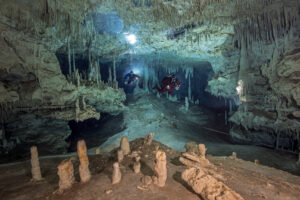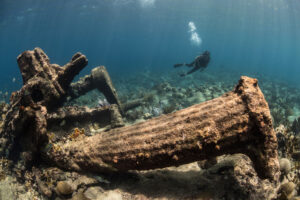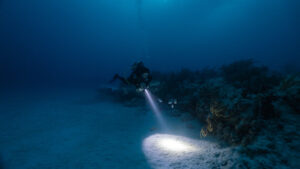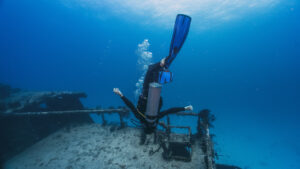What is Heliox?
Heliox is a breathing gas mixture composed of helium and oxygen, widely used in deep-sea diving due to its unique properties that improve safety and performance under extreme conditions. Unlike standard air, which consists of approximately 78% nitrogen and 21% oxygen, Heliox replaces the nitrogen with helium. This substitution is crucial in mitigating the adverse effects of nitrogen narcosis and oxygen toxicity that divers can experience at greater depths. Heliox has been a game-changer for technical and commercial divers, enabling them to work and explore at depths that would otherwise be highly hazardous.
Historical Development
The use of Heliox in diving has a rich history that dates back to the early 20th century. Its potential was first recognized in the 1930s when researchers sought to address the limitations of air as a breathing gas for deep-sea divers. The United States Navy played a pivotal role in the development of Heliox, conducting extensive studies and experiments to understand its benefits and applications. Early trials demonstrated that Heliox could significantly reduce the risk of nitrogen narcosis, a condition that impairs cognitive and motor functions at high pressures.
By the 1960s, Heliox had become a standard gas mixture for deep-sea diving operations, particularly in commercial diving where divers frequently worked at depths exceeding 100 meters (328 feet). One of the most notable milestones was the Sealab project initiated by the U.S. Navy in the 1960s, which aimed to explore the feasibility of underwater habitats. Heliox was used extensively in these experiments, proving its efficacy and safety.
Over the decades, Heliox has been integral to numerous deep-sea expeditions and underwater engineering projects. It has facilitated the maintenance and repair of underwater structures, oil rigs, and pipelines, contributing significantly to the fields of marine biology, archaeology, and underwater construction. Today, Heliox continues to be a preferred gas mixture for deep diving, reflecting its enduring value and importance in the diving community.
Composition and Properties
Heliox is composed of a mixture of helium and oxygen, typically in ratios tailored to specific diving depths and conditions. The most common mixtures are 80% helium and 20% oxygen or 70% helium and 30% oxygen, though other ratios can be used depending on the requirements of the dive. The choice of mixture is critical as it affects both the physiological impact on the diver and the operational safety of the dive.
One of the primary advantages of helium is its low density compared to nitrogen. This property significantly reduces the work of breathing at depth, allowing divers to breathe more easily and reducing the strain on their respiratory system. Helium’s high thermal conductivity, however, means that it can increase heat loss from the body, making thermal protection a crucial consideration during Heliox dives.
In addition to its physical properties, Heliox also helps prevent nitrogen narcosis. Nitrogen narcosis is a condition caused by the increased partial pressure of nitrogen at depth, leading to symptoms such as dizziness, euphoria, and impaired judgment. By replacing nitrogen with helium, divers can operate more safely and effectively at greater depths. Heliox also helps in managing oxygen toxicity, a condition that can occur when breathing high concentrations of oxygen under pressure. Carefully controlled Heliox mixtures allow divers to maintain appropriate oxygen levels, minimizing this risk.
Physiological Effects
The physiological effects of Heliox are central to its effectiveness as a breathing gas for deep-sea diving. One of the most significant benefits is the reduction in nitrogen narcosis. Nitrogen, under high pressure, can have a narcotic effect on the brain, leading to impaired judgment and motor skills, which can be dangerous for divers. Helium, being inert and less soluble in blood and tissues than nitrogen, does not produce these narcotic effects, allowing divers to maintain clarity and coordination at depths where air breathing would be problematic.
Helium’s low density also plays a critical role in reducing the effort required to breathe at depth. As divers descend, the pressure increases, making the air denser and harder to breathe. Heliox, with its lower density, alleviates this issue, making breathing more efficient and less tiring. This is particularly important for prolonged dives where respiratory fatigue can become a significant concern.
Another vital aspect of Heliox is its impact on decompression. Helium diffuses more rapidly than nitrogen, which can reduce the time required for decompression stops during ascent. This rapid diffusion helps in minimizing the formation of nitrogen bubbles in tissues, thereby reducing the risk of decompression sickness, commonly known as “the bends.” However, careful management is essential, as rapid ascent with Heliox can still pose risks if not properly controlled.
Furthermore, Heliox helps in managing oxygen toxicity, a potentially fatal condition that can occur when breathing high levels of oxygen at increased pressures. By adjusting the oxygen concentration in the Heliox mixture, divers can operate at depths where pure oxygen or high oxygen mixtures would be dangerous. This flexibility in gas composition is crucial for ensuring both the safety and effectiveness of deep-sea operations.
Applications in Scuba Diving
Heliox has a wide range of applications in scuba diving, particularly in technical and commercial diving scenarios. One of the primary uses is in deep-sea diving, where standard air or even nitrox (a nitrogen-oxygen mix) would pose significant risks due to nitrogen narcosis and oxygen toxicity. Heliox enables divers to reach depths beyond 100 meters (328 feet), making it indispensable for operations such as underwater construction, repair of oil rigs, and deep-sea exploration.
Commercial divers often use Heliox for tasks that require extended periods underwater at significant depths. For instance, the maintenance and repair of underwater pipelines and oil platforms frequently necessitate dives well beyond the safe limits of air or nitrox. In these scenarios, Heliox provides a safer and more efficient alternative, allowing divers to perform their tasks with reduced risk and greater effectiveness.
Heliox is also used in scientific research, particularly in marine biology and underwater archaeology. Researchers studying deep-sea ecosystems or exploring ancient shipwrecks rely on Heliox to safely conduct their investigations at depths that would be otherwise inaccessible. The ability to operate at such depths without the debilitating effects of nitrogen narcosis or the risk of oxygen toxicity is crucial for collecting accurate data and ensuring the safety of the divers.
Case studies from various underwater projects highlight the effectiveness of Heliox. For example, during the exploration of the Andrea Doria shipwreck, located at a depth of approximately 75 meters (246 feet), divers used Heliox to safely access and document the site. Similarly, Heliox has been used in the inspection and maintenance of underwater structures in the North Sea, where harsh conditions and significant depths pose challenges that Heliox helps to mitigate.
Training and Safety Considerations
Using Heliox for diving requires specialized training and rigorous safety protocols. Divers must undergo comprehensive training to understand the unique properties of Heliox and how to manage the potential risks associated with its use. This training typically includes both theoretical instruction and practical experience under controlled conditions.
One of the key aspects of Heliox training is learning to manage the physiological effects of diving at depth. Divers must be familiar with the symptoms of nitrogen narcosis, oxygen toxicity, and decompression sickness, and know how to respond effectively to these conditions. Training also covers the use of specialized equipment, such as rebreathers and mixed-gas diving systems, which are essential for Heliox dives.
Safety protocols for Heliox diving are stringent and must be followed meticulously. These protocols include detailed pre-dive planning, careful monitoring of gas mixtures, and adherence to decompression schedules. Divers must also be prepared for emergencies, with contingency plans in place for dealing with equipment failures, gas supply issues, or medical emergencies.
Proper equipment maintenance is another critical component of Heliox diving safety. Heliox-compatible equipment, such as regulators and rebreathers, must be regularly inspected and serviced to ensure optimal performance and reliability. Given the potential for increased heat loss when using Heliox, thermal protection is also crucial. Divers must use appropriate exposure suits and manage their body temperature to prevent hypothermia.
Overall, the combination of specialized training and rigorous safety measures ensures that divers can use Heliox effectively and safely, maximizing the benefits of this unique breathing gas while minimizing the associated risks.
Technological and Research Advancements
Advancements in technology and ongoing research continue to enhance the safety and efficiency of Heliox diving. One significant development is the improvement of rebreather systems, which recycle exhaled gases, allowing for longer dive times and more efficient gas usage. Modern rebreathers are equipped with sophisticated sensors and control systems that automatically adjust gas mixtures, ensuring optimal breathing conditions throughout the dive.
Research in diving medicine has also contributed to better understanding the physiological impacts of Heliox and how to mitigate potential risks. Studies on decompression sickness, for example, have led to more accurate decompression models and safer ascent protocols. These advancements help divers manage the complex dynamics of gas absorption and release in the body, reducing the likelihood of decompression-related injuries.
Another area of innovation is the development of more efficient and reliable gas blending systems. These systems allow for precise mixing of helium and oxygen, ensuring that divers receive the correct gas mixture for their specific diving conditions. Advances in portable gas blending technology have made it easier to prepare Heliox on-site, providing greater flexibility and convenience for divers operating in remote or challenging environments.
Ongoing research also explores the potential of Heliox for new applications and deeper dives. Scientists and engineers are continually pushing the boundaries of what is possible with Heliox, exploring its use in hyperbaric medicine, underwater habitats, and extreme depth exploration. These efforts not only expand the capabilities of Heliox but also enhance our understanding of human physiology under pressure, contributing to broader medical and scientific knowledge.
Key Takeaways
Heliox, a mixture of helium and oxygen, plays a crucial role in deep-sea diving, enabling divers to operate safely at significant depths. Its unique properties reduce the risks of nitrogen narcosis and oxygen toxicity, making it indispensable for technical and commercial diving. The historical development, physiological effects, applications, and safety considerations of Heliox underscore its importance and utility. Continued advancements in technology and research promise to further enhance its effectiveness, ensuring that Heliox remains a vital tool for divers and researchers alike.

















